Barbara De Salvo
Unlocking Visual Secrets: Inverting Features with Diffusion Priors for Image Reconstruction
Dec 11, 2024Abstract:Inverting visual representations within deep neural networks (DNNs) presents a challenging and important problem in the field of security and privacy for deep learning. The main goal is to invert the features of an unidentified target image generated by a pre-trained DNN, aiming to reconstruct the original image. Feature inversion holds particular significance in understanding the privacy leakage inherent in contemporary split DNN execution techniques, as well as in various applications based on the extracted DNN features. In this paper, we explore the use of diffusion models, a promising technique for image synthesis, to enhance feature inversion quality. We also investigate the potential of incorporating alternative forms of prior knowledge, such as textual prompts and cross-frame temporal correlations, to further improve the quality of inverted features. Our findings reveal that diffusion models can effectively leverage hidden information from the DNN features, resulting in superior reconstruction performance compared to previous methods. This research offers valuable insights into how diffusion models can enhance privacy and security within applications that are reliant on DNN features.
GazeGen: Gaze-Driven User Interaction for Visual Content Generation
Nov 07, 2024
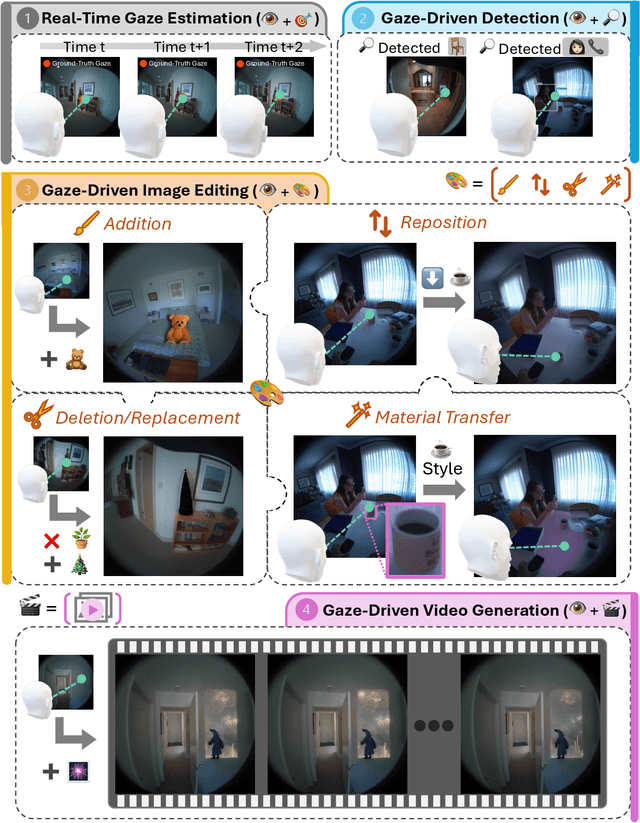

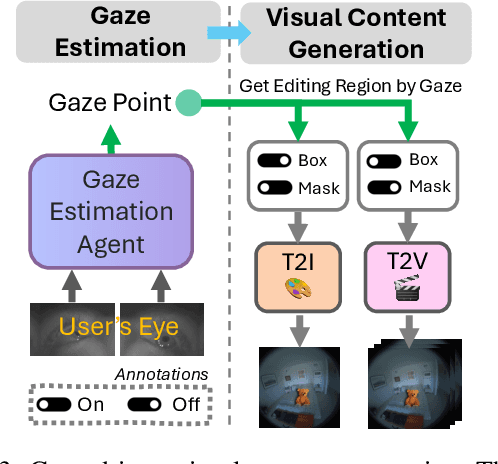
Abstract:We present GazeGen, a user interaction system that generates visual content (images and videos) for locations indicated by the user's eye gaze. GazeGen allows intuitive manipulation of visual content by targeting regions of interest with gaze. Using advanced techniques in object detection and generative AI, GazeGen performs gaze-controlled image adding/deleting, repositioning, and surface material changes of image objects, and converts static images into videos. Central to GazeGen is the DFT Gaze (Distilled and Fine-Tuned Gaze) agent, an ultra-lightweight model with only 281K parameters, performing accurate real-time gaze predictions tailored to individual users' eyes on small edge devices. GazeGen is the first system to combine visual content generation with real-time gaze estimation, made possible exclusively by DFT Gaze. This real-time gaze estimation enables various visual content generation tasks, all controlled by the user's gaze. The input for DFT Gaze is the user's eye images, while the inputs for visual content generation are the user's view and the predicted gaze point from DFT Gaze. To achieve efficient gaze predictions, we derive the small model from a large model (10x larger) via novel knowledge distillation and personal adaptation techniques. We integrate knowledge distillation with a masked autoencoder, developing a compact yet powerful gaze estimation model. This model is further fine-tuned with Adapters, enabling highly accurate and personalized gaze predictions with minimal user input. DFT Gaze ensures low-latency and precise gaze tracking, supporting a wide range of gaze-driven tasks. We validate the performance of DFT Gaze on AEA and OpenEDS2020 benchmarks, demonstrating low angular gaze error and low latency on the edge device (Raspberry Pi 4). Furthermore, we describe applications of GazeGen, illustrating its versatility and effectiveness in various usage scenarios.
x-RAGE: eXtended Reality -- Action & Gesture Events Dataset
Oct 25, 2024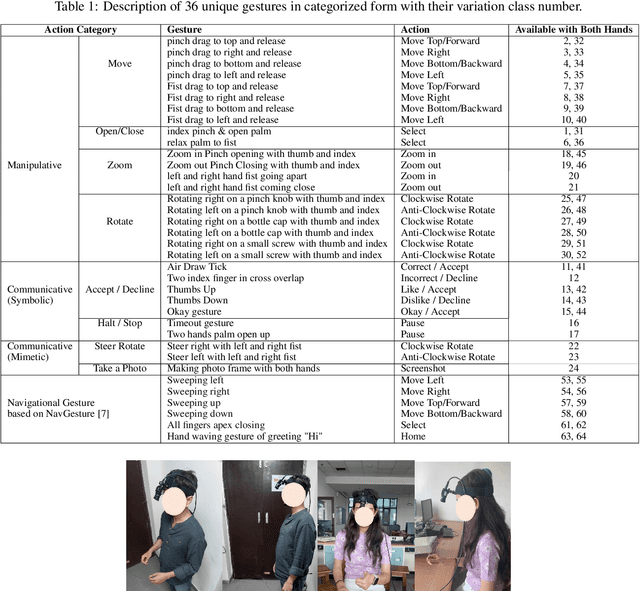
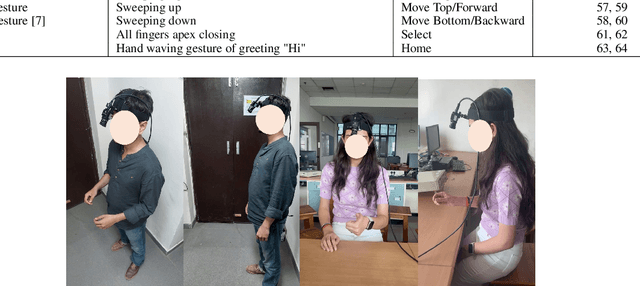
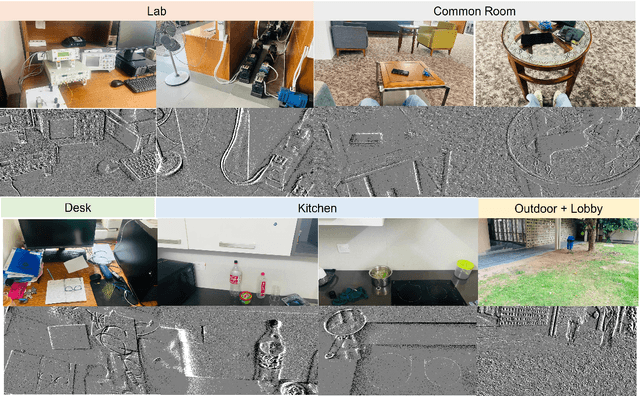

Abstract:With the emergence of the Metaverse and focus on wearable devices in the recent years gesture based human-computer interaction has gained significance. To enable gesture recognition for VR/AR headsets and glasses several datasets focusing on egocentric i.e. first-person view have emerged in recent years. However, standard frame-based vision suffers from limitations in data bandwidth requirements as well as ability to capture fast motions. To overcome these limitation bio-inspired approaches such as event-based cameras present an attractive alternative. In this work, we present the first event-camera based egocentric gesture dataset for enabling neuromorphic, low-power solutions for XR-centric gesture recognition. The dataset has been made available publicly at the following URL: https://gitlab.com/NVM_IITD_Research/xrage.
PETAH: Parameter Efficient Task Adaptation for Hybrid Transformers in a resource-limited Context
Oct 23, 2024Abstract:Following their success in natural language processing (NLP), there has been a shift towards transformer models in computer vision. While transformers perform well and offer promising multi-tasking performance, due to their high compute requirements, many resource-constrained applications still rely on convolutional or hybrid models that combine the benefits of convolution and attention layers and achieve the best results in the sub 100M parameter range. Simultaneously, task adaptation techniques that allow for the use of one shared transformer backbone for multiple downstream tasks, resulting in great storage savings at negligible cost in performance, have not yet been adopted for hybrid transformers. In this work, we investigate how to achieve the best task-adaptation performance and introduce PETAH: Parameter Efficient Task Adaptation for Hybrid Transformers. We further combine PETAH adaptation with pruning to achieve highly performant and storage friendly models for multi-tasking. In our extensive evaluation on classification and other vision tasks, we demonstrate that our PETAH-adapted hybrid models outperform established task-adaptation techniques for ViTs while requiring fewer parameters and being more efficient on mobile hardware.
Neural Architecture Search of Hybrid Models for NPU-CIM Heterogeneous AR/VR Devices
Oct 10, 2024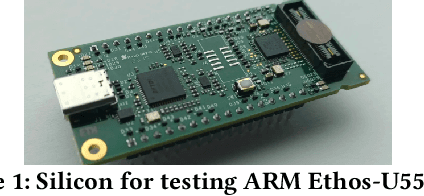
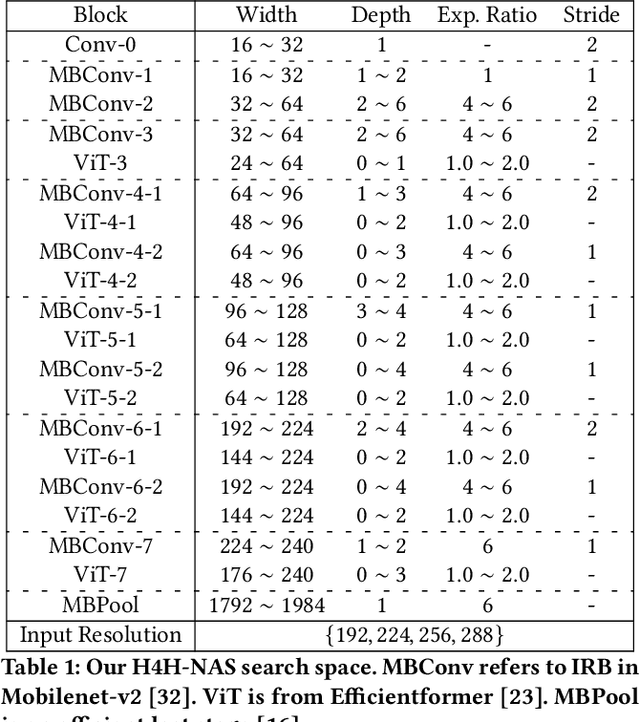

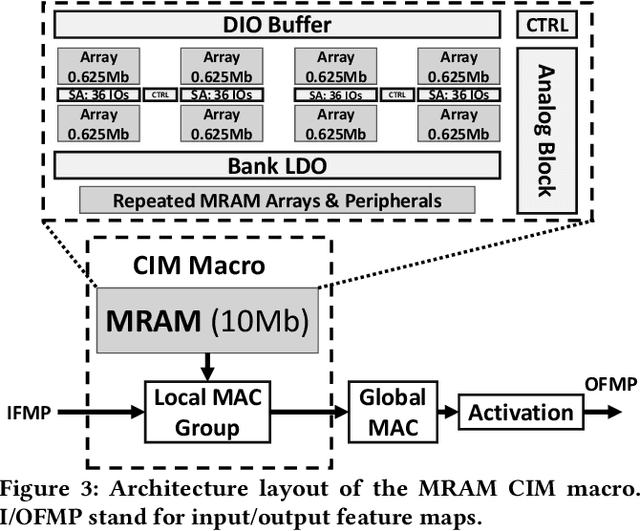
Abstract:Low-Latency and Low-Power Edge AI is essential for Virtual Reality and Augmented Reality applications. Recent advances show that hybrid models, combining convolution layers (CNN) and transformers (ViT), often achieve superior accuracy/performance tradeoff on various computer vision and machine learning (ML) tasks. However, hybrid ML models can pose system challenges for latency and energy-efficiency due to their diverse nature in dataflow and memory access patterns. In this work, we leverage the architecture heterogeneity from Neural Processing Units (NPU) and Compute-In-Memory (CIM) and perform diverse execution schemas to efficiently execute these hybrid models. We also introduce H4H-NAS, a Neural Architecture Search framework to design efficient hybrid CNN/ViT models for heterogeneous edge systems with both NPU and CIM. Our H4H-NAS approach is powered by a performance estimator built with NPU performance results measured on real silicon, and CIM performance based on industry IPs. H4H-NAS searches hybrid CNN/ViT models with fine granularity and achieves significant (up to 1.34%) top-1 accuracy improvement on ImageNet dataset. Moreover, results from our Algo/HW co-design reveal up to 56.08% overall latency and 41.72% energy improvements by introducing such heterogeneous computing over baseline solutions. The framework guides the design of hybrid network architectures and system architectures of NPU+CIM heterogeneous systems.
DRESS: Dynamic REal-time Sparse Subnets
Jul 01, 2022

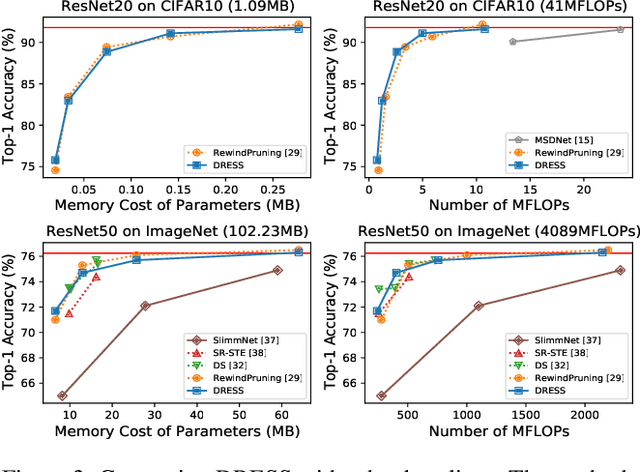
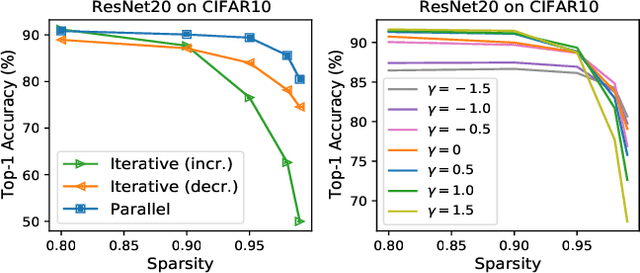
Abstract:The limited and dynamically varied resources on edge devices motivate us to deploy an optimized deep neural network that can adapt its sub-networks to fit in different resource constraints. However, existing works often build sub-networks through searching different network architectures in a hand-crafted sampling space, which not only can result in a subpar performance but also may cause on-device re-configuration overhead. In this paper, we propose a novel training algorithm, Dynamic REal-time Sparse Subnets (DRESS). DRESS samples multiple sub-networks from the same backbone network through row-based unstructured sparsity, and jointly trains these sub-networks in parallel with weighted loss. DRESS also exploits strategies including parameter reusing and row-based fine-grained sampling for efficient storage consumption and efficient on-device adaptation. Extensive experiments on public vision datasets show that DRESS yields significantly higher accuracy than state-of-the-art sub-networks.
Memory-Oriented Design-Space Exploration of Edge-AI Hardware for XR Applications
Jun 08, 2022
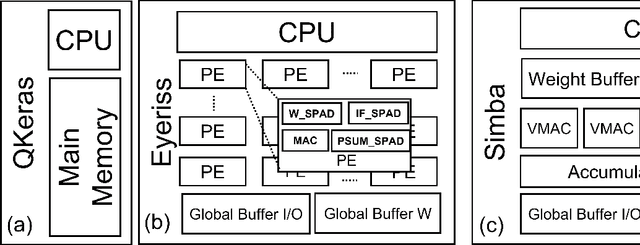
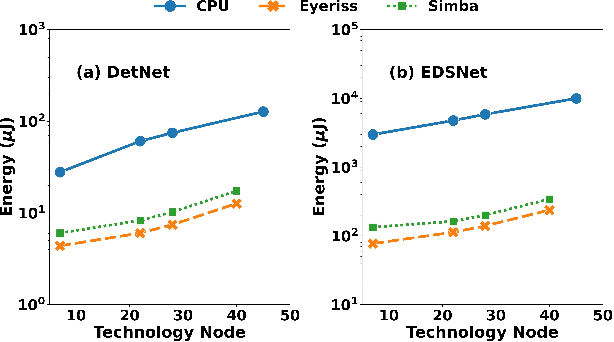
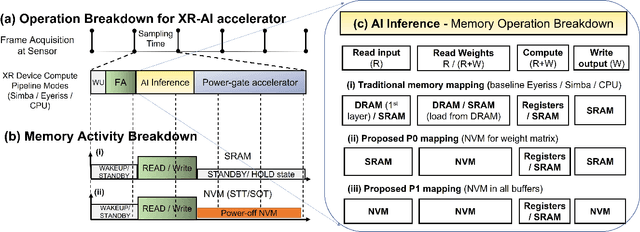
Abstract:Low-Power Edge-AI capabilities are essential for on-device extended reality (XR) applications to support the vision of Metaverse. In this work, we investigate two representative XR workloads: (i) Hand detection and (ii) Eye segmentation, for hardware design space exploration. For both applications, we train deep neural networks and analyze the impact of quantization and hardware specific bottlenecks. Through simulations, we evaluate a CPU and two systolic inference accelerator implementations. Next, we compare these hardware solutions with advanced technology nodes. The impact of integrating state-of-the-art emerging non-volatile memory technology (STT/SOT/VGSOT MRAM) into the XR-AI inference pipeline is evaluated. We found that significant energy benefits (>=80%) can be achieved for hand detection (IPS=40) and eye segmentation (IPS=6) by introducing non-volatile memory in the memory hierarchy for designs at 7nm node while meeting minimum IPS (inference per second). Moreover, we can realize substantial reduction in area (>=30%) owing to the small form factor of MRAM compared to traditional SRAM.
SplitNets: Designing Neural Architectures for Efficient Distributed Computing on Head-Mounted Systems
Apr 10, 2022
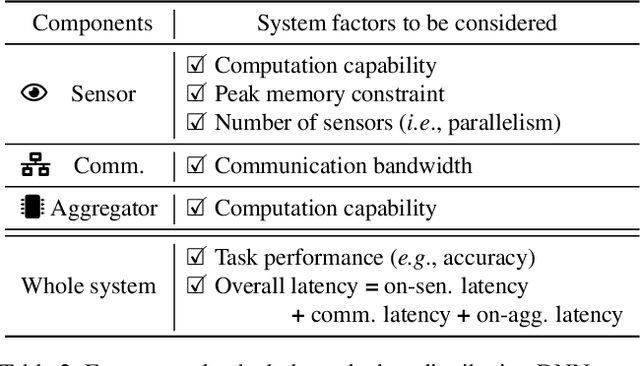
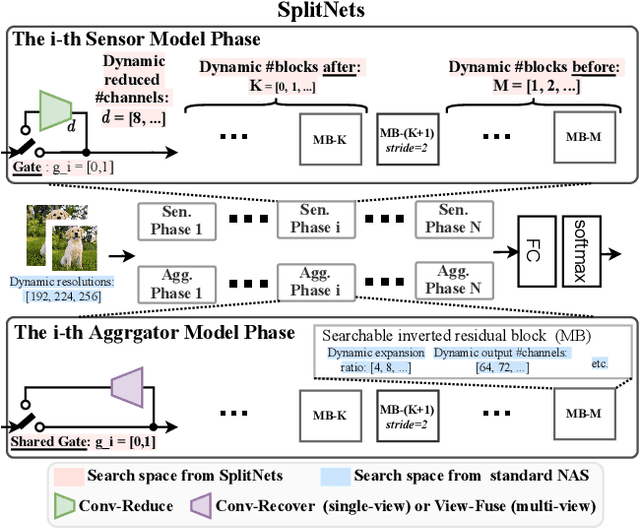

Abstract:We design deep neural networks (DNNs) and corresponding networks' splittings to distribute DNNs' workload to camera sensors and a centralized aggregator on head mounted devices to meet system performance targets in inference accuracy and latency under the given hardware resource constraints. To achieve an optimal balance among computation, communication, and performance, a split-aware neural architecture search framework, SplitNets, is introduced to conduct model designing, splitting, and communication reduction simultaneously. We further extend the framework to multi-view systems for learning to fuse inputs from multiple camera sensors with optimal performance and systemic efficiency. We validate SplitNets for single-view system on ImageNet as well as multi-view system on 3D classification, and show that the SplitNets framework achieves state-of-the-art (SOTA) performance and system latency compared with existing approaches.
Distributed On-Sensor Compute System for AR/VR Devices: A Semi-Analytical Simulation Framework for Power Estimation
Mar 14, 2022
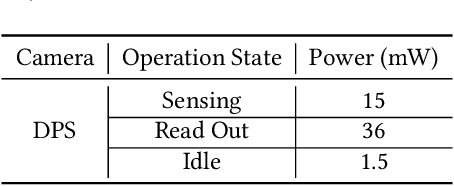


Abstract:Augmented Reality/Virtual Reality (AR/VR) glasses are widely foreseen as the next generation computing platform. AR/VR glasses are a complex "system of systems" which must satisfy stringent form factor, computing-, power- and thermal- requirements. In this paper, we will show that a novel distributed on-sensor compute architecture, coupled with new semiconductor technologies (such as dense 3D-IC interconnects and Spin-Transfer Torque Magneto Random Access Memory, STT-MRAM) and, most importantly, a full hardware-software co-optimization are the solutions to achieve attractive and socially acceptable AR/VR glasses. To this end, we developed a semi-analytical simulation framework to estimate the power consumption of novel AR/VR distributed on-sensor computing architectures. The model allows the optimization of the main technological features of the system modules, as well as the computer-vision algorithm partition strategy across the distributed compute architecture. We show that, in the case of the compute-intensive machine learning based Hand Tracking algorithm, the distributed on-sensor compute architecture can reduce the system power consumption compared to a centralized system, with the additional benefits in terms of latency and privacy.
Power-of-Two Quantization for Low Bitwidth and Hardware Compliant Neural Networks
Mar 09, 2022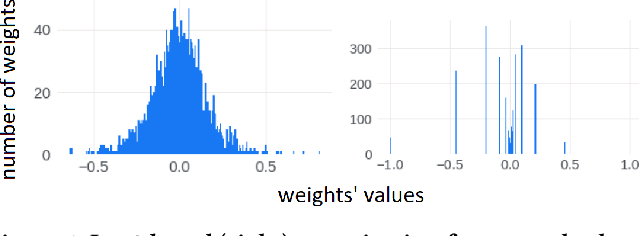
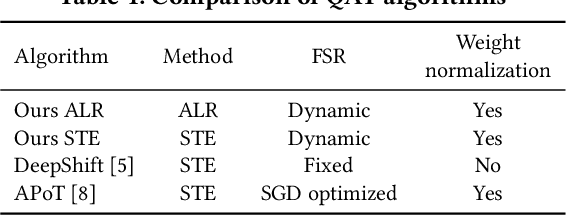
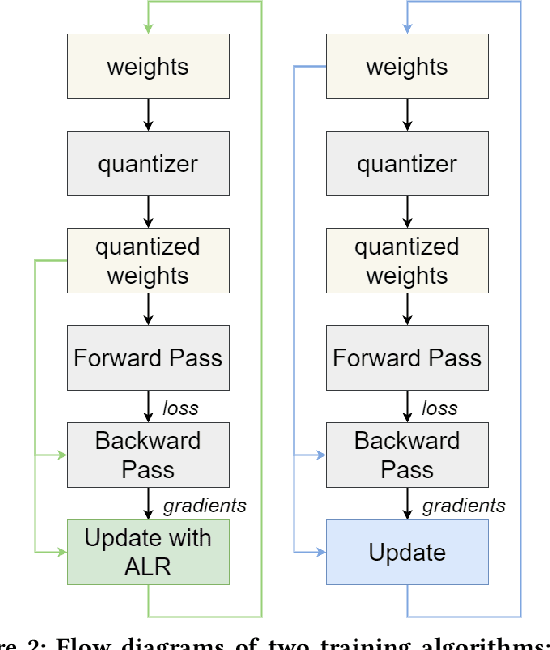
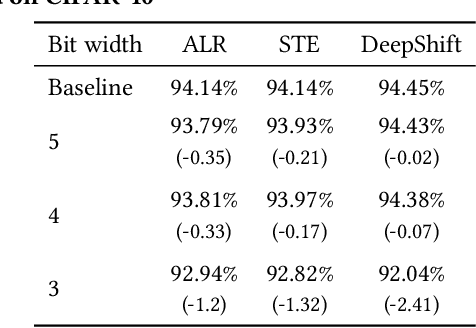
Abstract:Deploying Deep Neural Networks in low-power embedded devices for real time-constrained applications requires optimization of memory and computational complexity of the networks, usually by quantizing the weights. Most of the existing works employ linear quantization which causes considerable degradation in accuracy for weight bit widths lower than 8. Since the distribution of weights is usually non-uniform (with most weights concentrated around zero), other methods, such as logarithmic quantization, are more suitable as they are able to preserve the shape of the weight distribution more precise. Moreover, using base-2 logarithmic representation allows optimizing the multiplication by replacing it with bit shifting. In this paper, we explore non-linear quantization techniques for exploiting lower bit precision and identify favorable hardware implementation options. We developed the Quantization Aware Training (QAT) algorithm that allowed training of low bit width Power-of-Two (PoT) networks and achieved accuracies on par with state-of-the-art floating point models for different tasks. We explored PoT weight encoding techniques and investigated hardware designs of MAC units for three different quantization schemes - uniform, PoT and Additive-PoT (APoT) - to show the increased efficiency when using the proposed approach. Eventually, the experiments showed that for low bit width precision, non-uniform quantization performs better than uniform, and at the same time, PoT quantization vastly reduces the computational complexity of the neural network.
 Add to Chrome
Add to Chrome Add to Firefox
Add to Firefox Add to Edge
Add to Edge